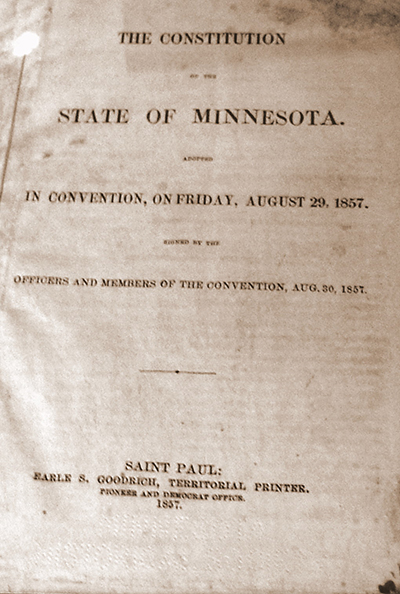Minnesota Government
Founding Documents
Minnesota Constitution 1858
In accordance with the enabling act of February 26, 1857, an election was held on June 1, 1857, at which Republican and Democratic delegates were elected to the constitutional convention. When these delegates assembled in St. Paul on July 13, 1857, to draft the Minnesota constitution, bitterness between the two parties was so intense that Republican delegates and Democratic delegates refused to meet in the same convention. As a result each party held separate sessions in different rooms of the first capitol building.
The Democratic “convention” was presided over by Henry H. Sibley, later elected first governor of Minnesota. The Republican “convention” was presided over first by John W. North, and later by St. Andrew D. Balcombe.
The political cleavage was so great that the two bodies never acted in joint meeting during the entire constitutional convention: July 13 to Aug. 29. The final work was done through a conference committee composed of five conferees from each of the conventions. The conferees, by reporting to and receiving advice from their respective conventions, were able to draft a constitution that would be acceptable to both bodies. On August 28, 1857, in spite of numerous protests by delegates, the report of the conference committee was adopted without amendment by both the Republican and Democratic conventions.

However, when it came time to sign the constitution, the bitter feeling was still so intense that Democrats would not sign an instrument which bore Republican signatures, and the Republicans objected to signing an instrument that bore the signatures of Democrats. The solution to this impasse: two constitutions. One constitution was written on white paper and signed only by Republicans. The other constitution was written on blue-tinted paper and signed only by Democrats.
Thus, on the 29th day of August, after seven weeks of political dispute and disagreement, the two conventions adjourned when as many members as could bring themselves to do so signed the copy of the constitution enrolled for their particular convention.
The schedule to the constitution provided for an election to be held on October 13, 1857. At this election the voters were to accept or reject the constitution. The ballots used for this purpose were printed to provide only for affirmative votes. A voter who wished to reject the constitution had to alter his ballot and write in a negative vote. The result: 30,055 for acceptance and 571 for rejection.
The procedure for acquiring statehood not only requires a constitution to be approved by the voters of the proposed state, the constitution must also be approved by Congress. In December of 1857 the Minnesota constitution was submitted to the United States Senate for ratification.
A certified copy of the Democratic constitution was transmitted to the senate by the territorial secretary: a Democrat. This copy was attached to the bill for the admission of Minnesota into the union. However, when the bill was reported back from the senate, historians report that the Republican constitution was attached. In any event, there is substantial authority that both constitutions were before Congress when Minnesota was admitted to the union on May 11, 1858.
In reality, the constitution ratified by Congress was not the original constitution. At the election of October 13, 1857, in addition to voting on the constitution, the voters elected executive, legislative and judicial officers. The state officers were content to wait for the act of Congress before assuming office. But the legislature took a contrary view. It convened on December 3, 1857, on the theory that under the enabling act the statehood of Minnesota began when the voters approved the constitution. Even though this theory was incorrect, the legislature proceeded to enact laws, the effects of which have remained undisturbed by the courts.
The first two acts passed by the legislature were proposed amendments to the constitution. One amendment authorized a loan to railroads of $5 million and the other related to the term of office of the first state officers. These amendments were ratified by the voters at a special election held April 15, 1858. It would appear that the constitution that Congress approved on May 11, 1858, was an amended constitution, not the original adopted by the constitutional convention and approved by the voters in 1857.
The legislature in 1971 established a constitutional study commission to review the constitution and make recommendations to maintain its utility. After two years’ study, the commission recommended that an amendment restructuring the constitution for easy reference and rewriting it in modern language be prepared.
The amendment was introduced and passed in both houses, signed by the governor, and approved by the voters on November 5, 1974. The previous wording of the constitution is printed, with all the amendments approved by voters since its adoption in 1857, in the Minnesota Legislative Manual 1973–74, pages 445–484. The amendment approved in 1974 did not alter the meaning of the constitution. In cases of constitutional law, the original document remains the final authority.